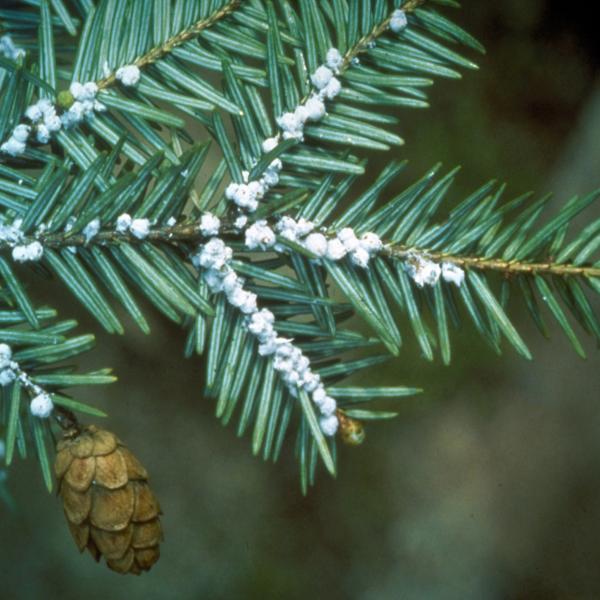
The winter of 2014-2015 was tough on hemlock woolly adelgid; 97 to 99 percent of the sistens, or winter, generation died. The previous winter had similar winter mortality rates. This helped to give hemlock trees a bit of a reprieve. But, while these recent mortality rates have been high enough to temporarily stop the spread of HWA, the trees are still threatened.
One element of the threat is the adelgid’s amazing reproductive capacity. Surviving sistens laid eggs early in the spring; up to 300 each. These eggs give rise to the short-lived spring generation, also known progrediens. In early summer, each of them laid as many as 100 eggs. So if even one adelgid survives the winter as many as 30,000 could enter the next winter. And the infestation continues.
Another stress on hemlock trees has been our summer weather. The HWA infested area has been in drought conditions for a substantial period. Because of its shallow root system, hemlock is susceptible to drought. Some stands of hemlock, particularly on ledgy sites, are in noticeable decline.
Compounding the situation is the discovery of elongate hemlock scale in southern Windham County. Elongate hemlock scale is another invasive forest pest. EHS has been found in conjunction with HWA. While adelgids feed on the twigs, EHS feeds on the needles. This one-two punch can hasten the death of a tree.
Given the threatened state of hemlocks in southern Vermont, the Department of Forests, Parks and Recreation is very interested in gathering information about the extent of the HWA/EHS infestation and the condition of hemlock trees. Volunteers are needed to assist in this effort. Training and technical advice is available. Contact Jim Esden at jim.esden@vermont.gov
The surveying season will start soon. As cooler autumn weather sets in, sistens that have been inactive through the heat of summer, will begin to feed and develop the fuzzy, white flocculence that gives them their name and helps us to spot them. In southern Vermont, this typically begins in mid-October and lasts through the winter. HWA surveying is good fun and can be incorporated with other outdoor activities like hiking, snowshoeing, skiing, hunting, snowmobiling, birding and more. Two people can usually do the typical survey in one or two hours.
In the coming months, staff from the Department of Forests, Parks and Recreation (FPR) will be involved in two biocontrol projects.
Fall is also the time to monitor release sites for Laricobius nigrinus, a predator of hemlock woolly adelgid. This small, black beetle has been released in three sites in hopes that it will become established and help to reduce HWA populations. Monitoring has shown that the beetles had survived earlier winters but, there is concern about how well they may have done through a winter that killed up to 99 percent of its food. FPR is applying to receive more beetles to augment earlier releases.
The second project is still experimental. FPR will be cooperating with researchers from UVM to find sites for experiments to determine if another HWA predator might be appropriate for use in the East. This insect is a silver fly from the Northwest. It has been found to prey on HWA and will be tested in several places, including Vermont.
Status reports on HWA have been good news/bad news – maybe even good news/bad news/bad news – lately. But the battle is not lost. There is much to do and the hemlock is such an important resource, that it is worth the effort. Many agencies, universities and private groups have joined the fight. In Vermont, volunteers have long been, and continue to be, a crucial part of the effort. There are several opportunities for those interested; contact Jim Esden – jim.esden@vermont.gov .
For the latest information about identifying and managing HWA and EHS, read Managing Hemlock in Northern New England Forests Threatened by Hemlock Woolly Adeglid and Elongate Hemlock Scale, published by the USDA Forest Service, September 2015.
Article by Jim Esden, VT Dept of Forests, Parks, and Rec
Photo by James Johnson, Georgia Forestry Commission, Bugwood.org